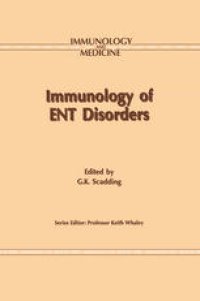
Ebook: Immunology of ENT Disorders
- Tags: Immunology, Otorhinolaryngology
- Series: Immunology and Medicine Series 23
- Year: 1994
- Publisher: Springer Netherlands
- Edition: 1
- Language: English
- pdf
Until recently, the contribution of immunological knowledge to the under standingand management ofENTdisorders was slight, being largely confined to the appreciation that many rhinitic patients were allergic. Happily, this situation is rapidly changing: the immunological basis of many disorders of the ears, nose and throat is becoming recognized and the mechanisms of the reactions involved are being elucidated. From this, rational therapy should evolve. This book aims to highlight some of the areas in which immunological mechanisms are involved in otorhinolaryngology. It is written by experts in their respective fields of immunology and allergy, otology, rhinology and pathology. It opens with an overview ofthe pathways ofthe immune response and the cells and molecules involved, leading to an appreciation of the normal defence mechanisms of the upper respiratory tract and possible areas offailure. There is then a chapter on HIV infection and how this may present to otorhinolaryngologists. The normal function of the tonsil and the immunological effects oftonsillectomy are then considered. The varying roles of fungi in ENT disorders ranging from commensal through allergen to invasive organisms is assessed by Professor R. J. Hay. Perhaps the most obvious immunological contribution to management thus far lies in the immunocytochemical diagnosis of pathological conditions of the ears, nose and throat and this is covered in a chapter by Professor Leslie Michaels.
This book highlights the areas in which immunological mechanisms are now known to be involved in disorders of the ears, nose and throat. These include the normal defence mechanisms of the upper respiratory tract, the immunology of the tonsils and failures of immunity, such as fungal infections, granulomatous disorders and malignancies. Disorders of the middle and inner ear are considered, as are nasal polyposis and various aspects of allergy: allergic rhinitis, and food sensitivity in relation to the nose and allergy. A final chapter deals with the future prospects for immunological involvement in ENT disorders.
The volume provides interesting insights, with possible novel therapeutic approaches, not only to otorhinolaryngologists, but also to audiologists, allergists and respiratory physicians. It also provides an up-to-date background for any immunological researcher in this field.